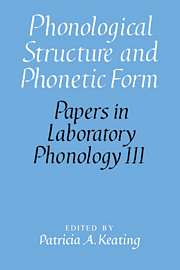Book contents
- Frontmatter
- Contents
- List of contributors
- Acknowledgments
- 1 Introduction
- I Intonation
- 2 Articulatory evidence for differentiating stress categories
- 3 “Stress shift” as early placement of pitch accents: a comment on Beckman and Edwards
- 4 Constraints on the gradient variability of pitch range, or, Pitch level 4 lives!
- 5 “Gesture” in prosody: comments on the paper by Ladd
- 6 What is the smallest prosodic domain?
- 7 The segment as smallest prosodic element: a curious hypothesis
- II Syllables
- III Feature Theory
- IV Phonetic Output
- Index of subjects
- Index of names
2 - Articulatory evidence for differentiating stress categories
Published online by Cambridge University Press: 26 February 2010
- Frontmatter
- Contents
- List of contributors
- Acknowledgments
- 1 Introduction
- I Intonation
- 2 Articulatory evidence for differentiating stress categories
- 3 “Stress shift” as early placement of pitch accents: a comment on Beckman and Edwards
- 4 Constraints on the gradient variability of pitch range, or, Pitch level 4 lives!
- 5 “Gesture” in prosody: comments on the paper by Ladd
- 6 What is the smallest prosodic domain?
- 7 The segment as smallest prosodic element: a curious hypothesis
- II Syllables
- III Feature Theory
- IV Phonetic Output
- Index of subjects
- Index of names
Summary
Introduction
Speech is structured both by the grammatical functions of contrast and organization and by the physical medium for those functions, namely sound as produced by the human vocal tract and perceived by the human ear. In investigating sound structure, neither the grammar nor the medium can be ignored. Each is an external source of constraint and explanation for facets of the other. A striking example of the dangers of ignoring either is the difficulty we have had in characterizing stress. It is only within the last ten years or so that phonological accounts of stress patterns have approached the level of descriptive insight afforded to segmental patterns by the phonetic observations of Panini. Conversely, investigations of physical and perceptual correlates of stress have produced many seemingly conflicting results, at least in part because of confusion concerning the phonological categories and structures involved.
In this paper, we will describe our understanding of what a unified theory of (surface) stress patterns must be like in general in order to be able to account for both the phonology and the phonetics of stress. We will then make a few proposals about how to fill in the specifics of the theory for a description of some parts of the English stress system, and show how this description might help account for the phonetics of stress shift. Finally, we will present some articulatory data in partial support for our specific proposals.
A theory of stress
One of the reasons why stress has been so difficult to characterize phonologically is that its salient function is not the familiar one of contrasting lexical items.
- Type
- Chapter
- Information
- Phonological Structure and Phonetic Form , pp. 7 - 33Publisher: Cambridge University PressPrint publication year: 1994
- 15
- Cited by



